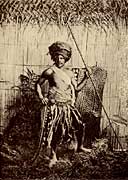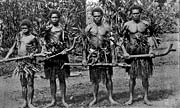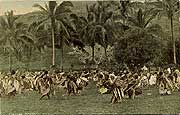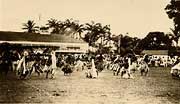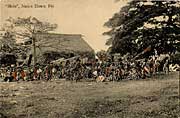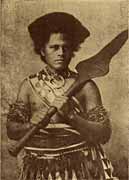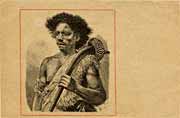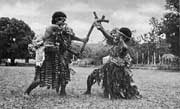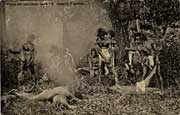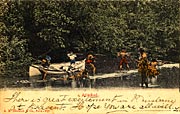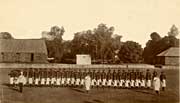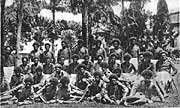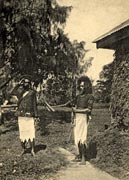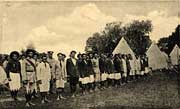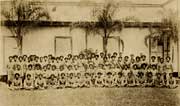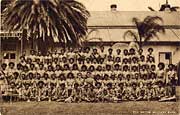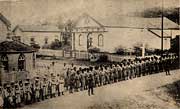|
"Fijian warrior". Unused. Publishers: Henry Marks & Co. This studio photo depicts a man wearing a pandanus, printed barkcloth and hibiscus-bark-fibre dance-skirt rather than a liku wäloa war-skirt. The latter were black and made of a particular kind of vine (see Dufty photos). He wears a headscarf (i-sala) of smoked red-brown barkcloth, sign of a chief, a barkcloth sash and cummerbund, and holds a sokilaki spear with tiered carved sections on the business end. |
|
|
"Krieger im Galaasnzuge. Fidschiinseln" [Warrior in Gala dress, Fiji Islands]. Unused. Publishers: Mission der Maristenperes in der Sudsee [Marist Bros Mission in Oceania]. This studio photo depicts a man wearing a liku wäloa war-skirt and a short knotted waistband of smoked masikuvui barkcloth waistband, sign of a chief. He shoulders a kiakavo common warclub. The only thing that makes his dress "gala dress" rather than true war dress is the magnificent split whaletooth wasekaseka gorget around his neck. This fine-looking man with his splendid head of hair was a favourite model of JohnWaters, who almost certainly took the original of this photo, around or shortly before 1900. It was almost certainly taken at the same time as the portrait head with gorget illustrated on the "People" webpage here. The same model can also be seen on the extreme left of the "Young Warriors" group in the next frame, and the two "cannibal" constructs below. |
|
|
"Young Fijian warriors". Used. No publisher, but No.33 on face. On verso: "Guaranteed Real Photo and British Manufacture." Has 1.5d George V stamp postmarked 9Fe30. Addressed to Capt.J.W.Diffold, Bank St., Seniculey PA, USA. Message dated 2/11/30 (i.e. Feb 11th) signed "Dr.Dodds". |
|
|
"Fijians in fighting dress". Caine series #35, Suva Fiji. Copyright. Unused. On verso: "Real Photo Postcard, British made." Actually, these men are dressed for a club dance, not for war. The rosettes on their pandanus skirts, and the flower behind one man's ear, make this quite clear. Already by the time this photo was taken (1900s), the men had reduced the extensive and complex face-paint they would formerly have worn, to a token black dot on forehead and/or cheeks, or some black powder rubbed casually on their faces. Every dancer carries a kiakavo spurred club, a common footsoldier's weapon, but the fact that this was the only sort they carried suggests that some of them at least would have been specifically made as dance-clubs. In former times, each dancer might have been expected to carry a favourite style of weapon. |
|
|
"Fijians in war dance costume". The Rose Series P #10020. Publisher "The Rose Stereographs" Sydney and Melbourne. Unused. Despite the absence of face-paint, these men are more authentically dressed for a club dance than those in the previous picture. Here each dancer carries what may have been a favourite style of weapon, two carry heavy waka rootstock clubs, and two have kiakavo spurred clubs similar to those in the previous photo. All but one of the clubs is sinnet-bound. The three adult men wear liku waloa black war-skirts, and all wear some foliage to make a display during dancing. |
|
|
"Fijian mekee [meke], Fiji". Handcoloured real photo. Unused, publisher and date unknown. Obviously early, but divided back so post-April 1906 when the regulations stipulating this came into effect. Probably betwwen 1906 and 1908. What is depicted here is a mekenivalu, or war-dance, performed with spears. Note the war-fans held by the dancers, and the low crouching posture that is not seen in this form in today's dances. At the time this photograph was taken, it is a reasonable supposition that at least some of the dancers would have performed such dances before "real" inter-group wars. |
|
|
"Spear dance, Levuka, Fiji". Published by "The Rose Stereographs", Armadale, Victoria. Identified on verso as "Real Photo. The 'Rose' Series De Luxe. Produced in Australia." Unused, and no date, but probably around 1920. |
|
|
"'Meke' , Native Dance, Fiji". Unused. Highlights in red added by hand. Published by Gus Arnold, Suva, Fiji. Undated but from the first decade of the 20th Century. The dance shown here is a wesi, with participants brandishing a spear in the right hand and a club in the other. Therefore there are no fans in evidence, since both hands are occupied. The dancer in the centre is brandishing a huge 4-pronged saisai dina. It, and several other spears, are decorated with strips of masi barkcloth. |
|
|
"Fiji Islands: Warrior in gala dress (Iles Fidji: Guerrier en tenue de gala)". Unused. Series 1, No.11 of a "Collection of views from the Marist Missions of Oceania" (Collection de vues des Missions Maristes d'Oceanie) This studio photo depicts a man wearing a liku wäloa war-skirt over his lower garment which cannot be seen clearly. The barkcloth of his cummerbund and shoulder-sash is from Cakaudrove Province, northeast Fiji. He wears a warrior's pig-tusk necklet, and on his shoulder bears a kinikini club, which in such a wide configuration was more a staff of office of a chief or priest than an assault weapon. |
|
|
Man with totokia warclub on his shoulder Unused. Undated. Publisher: Unknown, but Russian. Bears title on back in Cyrillic Script, plus "Union Postale Universelle, Russie". This is a reproduction of an old wood engraving. The totokia the man is carrying over his shoulder is unusually short but has a massive head. Often mistakenly called "pineapple clubs" because of this head, which was actually modelled after the fruit of the pandanus — the pineapple was introduced from South America by Europeans long after this club developed. It was one of two battle-hammers in common use in Fiji and should either be called by its proper name, or called a "Pandanus club" or "Beaked battle hammer". It was a specialist weapon, the pointed "beak" designed to peck a neat hole in the victim's skull after he/she had been felled with the heavy head. So fearsome is the appearance of the totokia that film director George Lucas made absolutely faithful reproductions of them to arm his “Tusken Raiders” in Star Wars! He re-named them Gaderffii (Gaffi) Sticks - https://airandspace.si.edu/exhibitions/star-wars/online/images/BookImages/sandman.jpg |
|
|
"Warriors, Fiji". Unused. Publisher: Co-Op # 3B236-N.(Stinson) Offset printed card. Undated, but probably 1930s. This unconvincing staged clubfight featuures two men dressed superficially like those in the photograph of warriors above, except for the tabuluva head-bands that are worn in dances. The clubs they are using are the standard footsoldiers' spur-clubs or kiakavo, often erroneously called 'gunstock clubs'. |
|
|
"Fijian club fighter". Unused. Publisher: Co-Op # 3B221-N. (Stinson). Offset printed card. Undated, but probably 1930s. Like many of the posed photos of this period, not only is the pose unconvincing, but details of costume are wrong. This man, for instance, wears a short-whaletooth necklace, a valuable item that would not be worn into war, or even, probably, in a club-dance, but reserved for ritual occasions. |
|
|
"Bay of Islands, Fiji". No publisher identified, but evidently the Co-Op (Stinson) because it shows the same man in the same setting as that above — obviously from the same "shoot". Offset printed card #402, BA-H1175. Unused & undated. While the original negative would have been made in the 1930s (when Stinson was operating as "Co-Op"), this card was probably produced in the 1940s-1950s by Stinson Studios. The same comments apply as to the previous photo, except that here the poor quality printing and lurid colours add to the feeling of incongruity. |
|
|
"Cannibals with body for a feast" Unused postcard, publisher Caine Series, Suva, Fiji #46 This cannibal scene was one of two staged by Thomas Andrew about 1890. His title for this picture, not shown on this reproduction, was "Vanquished". The other one, that he called "The Banquet", showed the events imagined to have followed. Both have been reproduced many times, by John Waters, F.W.Caine, Henry Marks, and others (Stephenson, 1997: 18-20). This particular card bears the claim "Copyright" after Caine's information on the back of the card, but obviously that can only be taken to have referred to the specific format of the card, NOT to the image, which like so many others in this period, was freely shared around. In this particular picture, the photographer apparently ran short of "props", as the man leading the procession carries not a club, but a coconut leaf spathe! That aside, however, they are correctly dressed for war, and though the staging occurred perhaps a decade or so after the last documented instances of cannibalism, the depiction of the contemptuous treatment of the corpses destined for consumption (for which there was a special word — bokola) seem historically accurate. The early Wesleyan missionary and qualified surgeon Richard B.Lyth recorded in his Journal for 1836-42 (p.437): "The bodies [from a recent massacre] being all brought into the presence of the ruling and the other chiefs, they were shortly given out one by one, in the same manner as they distribute pigs, and they were given to be roasted and eaten. As soon as one was disposed of the receiving party came forward, one of whom took hold of the cord fastened round the neck, two others seized the hands, and then hurried away with their prey, dragging it on the ground like a log of wood." |
|
|
"Pasto dei cannibali, Isole Fiji (Oceano Pacifico)." [Cannibal Meal, Fiji Islands (Pacific Ocean)] Unused postcard, publisher "Edit. British & Foreign Imports & Exports - Milan. Copyright 52845." This was the second of Thomas Andrew's staged productions, the title he gave to it being "The Banquet". The other one, that he called "Vanquished", appears in the previous cell. This Italian version must rank as one of the more unusual productions in the shared-image use discussed above. All of the remarks made for that picture apply to this. |
|
|
"Attacked" 1910 . Used postcard, hand-tinted. Publisher A.M.Brodziak & Co., Suva - Fiji. Dated 18.4.10 and addressed to Mrs G.Nesbitt, Blackall via Rockhampton, and posted in Brisbane (stamp removed). Another of the staged scenes of Fiji's savage past, real and imagined, presented for the Europeans of a safer era to thrill to. |
|
|
"Fiji Native Police". Publisher: Caine Series # 37. Unused and undated, but probably pre-1920. This photo of the police on parade may have been taken at Nasova, a suburb of Suva where the police barracks have always been. The large building on the left may indeed have been the barracks building — it is built in the style of the large houses in Bau and in Lomanikoro, Rewa, where the young unmarried men (cauravou) slept. |
|
|
"Fiji Constabulary". Publisher: Harry Gardiner. Original Collection: W.J. & R.M. Ewins. Gardiner did not start producing postcards until late 1917 so the probable date is during the decade following that date. In sharp contrast to the military precision of the policemen in the photo above, these men are very relaxed, presumably off-duty though still kitted out. |
|
|
"Native Police, Fiji". Publisher: Morris, Hedstromn & Co., Levuka Fiji. Printed Deutsche Erfindungen, Milano. Unused and undated, but pre-World War I. An officer (identifiable as such by his jacket and Sam Brown leather sash-belt) salutes while a sergeant presents arms with his rifle. The sergeant wears a tunic tucked in at the waist. Both wear the white kilts with zig-zag bottom edge, called isulutavatava ni ovisa. Neither, however, wears the leather sandals (ivävä ni ovisa) that later became standard dress for policemen. |
|
|
"Returned Fijian soldiers". Publisher: Harry Gardiner. Unused. Postage stamp square states "Printed in Germany". Original Collection: W.J. & R.M. Ewins. No date, but see comment in previous caption. Given the 1917+ date, it would seem that these "returned soldiers" were members of the Fijian Labour Detachment. Though Fijian soldiers were not permitted by the British Government to serve as combatants in the Great War, in 1917* Henry Marks, a prominent businessman and noted philanthropist, "in 1917, offered on behalf of himself and his firm £10,000 to cover the cost of raising, equipping and transporting to England or France, 100 Fijians for transport duty at Calais. The members of this Fijian Labour Detachment were popularly known as 'Marks's Boys'" (Elsie Stephenson, 1997: 67). * It was this fact that prompted Ratu Sukuna to enlist in the French Foreign Legion, earning the Croix de Guerre. |
|
|
|
"No.4 Platoon, Fiji Defence Force". Photographer: Harry Gardiner, Suva. No.92. Unused. Published by "The Rose Stereographs", Armadale, Victoria. Identified on verso as "Real Photo. The 'Rose' Series De Luxe. Produced in Australia." Original Collection: W.J. & R.M. Ewins. |
|
"Fiji Native Military Band". Unused. Tuck's Post Card. Publisher "Raphael Tuck & Sons Ltd., By Appointment". Copyright Fiji Government. Printed in England. Original Collection: W.J. & R.M. Ewins. On verso: "This is the native military band, which plays on the dock on the departure of the fine Mail Steamers which call at Suva every month." This custom was still observed when I left Fiji on the "Oronsay" in 1957. See picture in "Modern" section. |
|
|
"Navy and Army, Fiji ". Publisher: Harry Gardiner, Suva, Fiji (SK2557). Message written on back in French, dated 13/3/20. This parade is in Suva next to the Freemasons' Hall which still exists - in fact I sat my University Entrance exams in it many years ago! |
